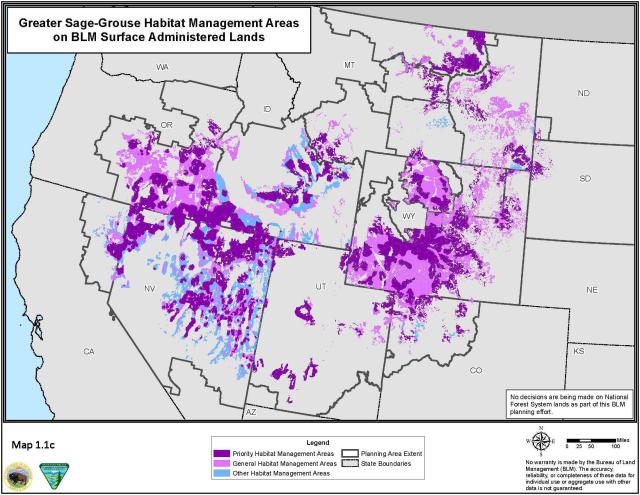In Balance: Range-wide consistency & Local flexibility
In 2015 the BLM adopted more than 70 management plans to safeguard sagebrush habitat on public lands we manage in 10 states, to sustain greater sage-grouse, other wildlife species that depend on this habitat, and Western communities who economic and cultural well-being is also tied to these lands.
The original plans and updates made in 2019 are built around designations of habitat management areas (HMAs) that state wildlife agencies help identify with mapping data and other on-the-ground information they use to manage wildlife populations, greater sage-grouse among them.
Close cooperation with state agencies is crucial because in North America, wildlife populations are managed by states or provinces. Managing wildlife habitat is the responsibility of the surface landowner. The BLM manages nearly 67 million of the 145 million acres of greater sage-grouse habitat in the United States, about 46%.

The U.S. Geological Survey reports that the number of greater sage-grouse across all habitats
has declined 37% in the last 20 years: populations once in the millions now number fewer than 800,000,
largely due to habitat loss. | GRSG Land Use Plan Amendments and EIS (2024), Map 1-1c. Appendix 1.
Our current effort to update the habitat plans uses the latest data from the states along with new scientific information published since 2015 to propose adjusting HMA boundaries where needed to keep pace with changing conditions that affect sagebrush habitat and contribute to ongoing declines in greater sage-grouse numbers.

the various phases of their life cycle. | BLM graphic
Two types of HMA are designated in every state.
Priority habitat management areas (PHMAs) have the highest value for sustaining sage-grouse populations. They may be areas for breeding, raising young or wintering, or lands that are important for migration and connectivity.
General habitat management areas (GHMAs) are lands outside of PHMA that are or have the potential to become seasonal or year-round habitat for sage-grouse.
Two other HMA types have been designated to align with state-specific wildlife policies and conservation approaches.
In Idaho, important habitat management areas (IHMAs) encompass moderate to high-quality habitat and sage-grouse populations that work as buffers for PHMA, connect patches of PHMA or in some cases support their own population and habitat.
In Montana, restoration HMAs are lands with ongoing or imminent impacts from human activity that nevertheless contained substantial, high-quality sage-grouse habitat and/or supported sustainable sage-grouse populations in the last 25 years.
A new type, stewardship habitat management areas (SHMAs), is being proposed in Wyoming. These areas tend to have large percentages of private land, existing disturbance, prior existing rights and fragmentation, compared with GHMA. Still, they also continue to support substantial sage-grouse populations which could benefit from management similar to that used in GHMAs.

and their newly hatched chicks. | USFWS / Tom Koerner; embedded image Cornell Lab / Gerrit Vyn
The alternatives in the draft environmental impact statement (EIS) offer flexibility for coordinating with state and local partners while maintaining consistency and sustainability across the 67 million acres of habitat on BLM-managed public lands. Section 2.5.2 in chapter 2 of the draft EIS describes the various types of HMAs. Appendix 3 describes the approaches each state took in identifying HMAs within their jurisdictions.
The draft EIS analyzes habitat objectives for each type of HMA along with management actions and land-use allocations that chart the course for meeting those objectives. Alternatives 3 and 6 would further designate some habitat as areas of critical environmental concern (ACECs), requiring special management to protect habitat resources.
GET INVOLVED | Review and comment on the draft environmental analysis of proposed options for protecting the greater sage-grouse's habitat on BLM-managed public lands. The public comment period is open through June 13, 2024.
We will review all submissions received during the comment period to identify substantive comments to consider
in developing the final EIS.
Commenting on the draft alternatives and draft impact analysis is not limited to voting up or down on information or management alternatives presented in the draft EIS.
The final EIS may revise or combine alternatives from the draft EIS in response to comments received and
further coordination with state, local and Tribal partners.
Heather Feeney, Public Affairs Specialist
Topic
Blog Topic:
Related Stories
- Easing trauma with public lands and resources
- PODCAST: BLM invests in Youth programs and projects nationwide using Inflation Reduction Act funds
- Using and sustaining sagebrush lands
- Objectives, measures & monitoring
- PODCAST: Cleaning up abandoned mine lands yields wildlife benefits in southwest New Mexico
